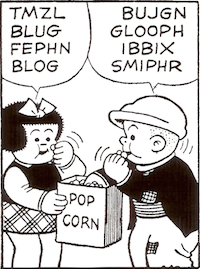[No spoilers.]
Soylent Green (dir. Richard Fleischer, 1973). It is 2022. The “greenhouse effect” leads to oppressive heat. Cities are overpopulated and covered in a yellow-brown haze. Citizens wear facemasks and generate electricity from car batteries and exercise bicycles. The homeless sleep on any available staircase. Scoops dispose of the unruly. And food has been replaced by “soylent” — little red, yellow, and green planks of nutrition. With great performances from Charlton Heston and Edward G. Robinson (in his last film). “There once was a world, you punk.” Best scene: Robinson watching movies.
And there are Blackwings.
*
Un peu de festival du Jacques Demy
Les horizons morts (1951). Demy’s short first film, in which the director stars as a young man with a broken heart. Here is the kernel of the full-length films that were to follow.
Le sabotier du Val de Loire (1956). A short documentary through a week in the life of a sabot maker: love, death, craftsmanship, modernity. As the camera watches this man splitting or carving wood or eating soup, every action feels like the most important thing in the world.
Ars (1959). The life of Jean-Marie Baptiste Vianney, parish priest, self-flagellant, saint. A strong Bresson influence here. The year 1959 marked the hundredth anniversary of Vianney’s death.
Lola (1961). Watch what happens, as Michel Legrand’s song says, as sailors, dancers, a young woman, a long-lost son, and an alienated young man (Marc Michel) criss-cross Nantes. Obscure objects of desire on the move, with every character another’s double or stand-in. At the center of it all, the dancer Cécile, now known as Lola (Anouk Aimée). Beautifully filmed in soft, milky black and white.

[“C’est moi, c’est Lola.“]
La luxure (1962). Demy’s contribution to The Seven Deadly Sins, a collection of short films by different directors. Wordplay, crassly charming pickup lines, a fantasia on Hieronymus Bosch, and music by Michel Legrand. The solemn world of the earliest Demy films is giving way to playful urbanity, and, of course, la luxure — lechery.
Bay of Angels (1963). A variation of sorts on Stefan Zweig’s story “Twenty-Four Hours in the Life of a Woman.” A newbie gambler (Claude Mann) vacations in Nice and meets up with an older (and compulsive) hand at roulette (Jeanne Moreau). Both gamblers smoke Lucky Strikes. Let the chips, or plaques, fall where they may.
The Umbrellas of Cherbourg (1964). A sweetbitter fairytale of love and loss and love. A jazz opera of sorts (with some brief metadialogue about preferring movies to opera — all that singing!). An influence on Mister Rogers’s operas? I wonder. Offscreen, the sorrows of war. With Catherine Deneuve, Nino Castelnuovo, and Lola’s Marc Michel.
The Young Girls of Rochefort (1967). A fair comes to town, and relationships rearrange themselves. Look, it’s Catherine Deneuve. And her ill-starred sister Françoise Dorléac. And Bernardo from West Side Story (George Chakiris). And Gene Kelly. And sailors. And they’re all singing and dancing. Or someone is singing for them. But they’re the ones dancing. This film made us happy beyond happy for all 126 of its minutes. And yes, it’s an inspiration for La La Land, but this film is the one to watch. Please, watch The Young Girls of Rochefort, before Netflix says “Very long wait.”

[Dorléac and Deneuve as twin sisters Solange and Delphine Garnier.]
We’re watching Demy via Criterion’s The Essential Jacques Demy. Two more to go.
*
Vicki (dir. Harry Horner, 1953). Social media and death. A publicity man (Elliott Reid) and a gossip columnist (Max Showalter) turn a waitress (Jean Peters) into a model and aspiring actress. And then she’s murdered. A remake of I Wake Up Screaming, with strong overtones of Laura, even in the music that plays behind the opening credits. With a strong performance by Richard Boone, who steps into Laird Cregar’s shoes as terrifying, obsessed cop Ed Cornell. Best line: “If men want to look at me, let them pay for it.”
*
Indignation (dir. James Schamus, 2016). A Jewish boy from Newark goes off to a Christian college in Ohio. (Why, exactly?) We stopped after twenty minutes or so, having watched long enough to see that this film is yet another version of mid-century America in which color filters turn everything into The Past. Or everything except the luminous blonde-haired student who will obviously be the protagonist’s undoing. From a Philip Roth novel.
*
City of Gold (dir. Laura Gabbert, 2016). A portrait of Los Angeles food writer Jonathan Gold, and a celebration of the delights to be found in strip malls, storefront restaurants, and food trucks. “In this completely ordinary place,” says, Gold, driving down yet another boulevard, “there happens to be extraordinary food.” He is utterly unpretentious in his appreciation of the world’s cuisines: Chinese, Ethiopian, Iranian, Korean, Mexican — and hot dogs and Squirt soda. Gold may be best known as the man who ate his way down Pico Boulevard. Best watched with food nearby.
Related reading
All OCA film posts (Pinboard)
Fourteen more films : Thirteen more : Twelve more : Another thirteen more : Another dozen : Yet another dozen : Another twelve : And another twelve : Still another twelve : Oh wait, twelve more : Twelve or thirteen more : Nine, ten, eleven — and that makes twelve : Another twelve





























